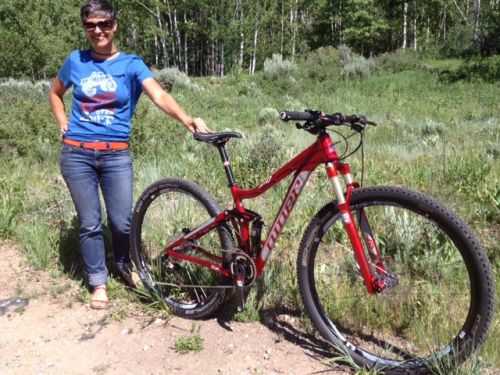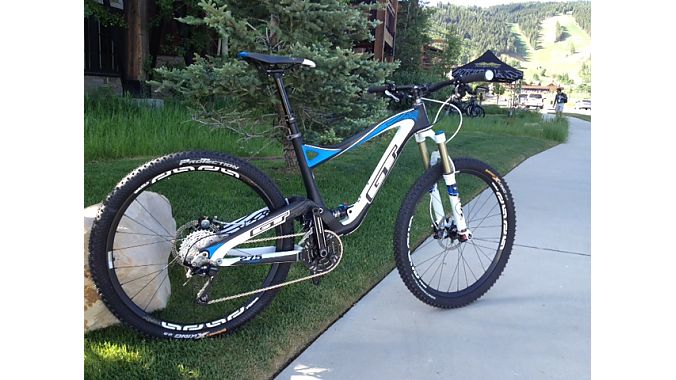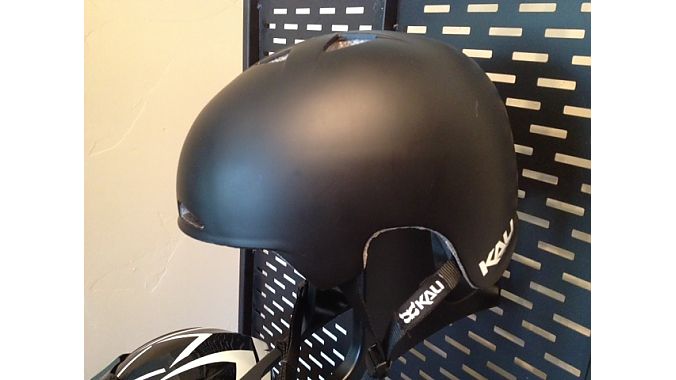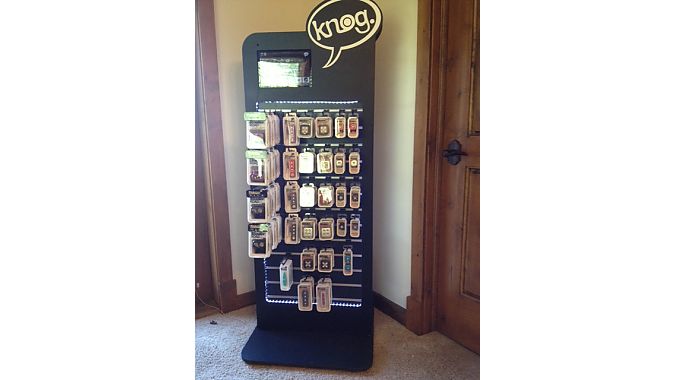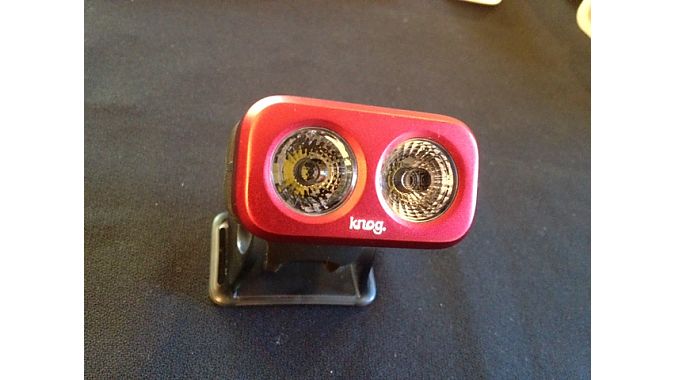PARK CITY, UT (BRAIN) — Lifeboat Events’ fifth annual Bike PressCamp kicked off Tuesday with 30 members of the cycling and mainstream media converging on Deer Valley to meet with more than 25 brands in the resort’s condos for some one-on-one face time and to preview upcoming 2014 product.
At the pre-event reception and dinner Monday night, Lifeboat founder and president Lance Camisasca said PressCamp 2013 is the most highly attended edition in the event’s history, drawing some 100 attendees, including brand representatives.
Meetings continue through Thursday. Be sure to check BRAIN for updates throughout the week. In the meantime, a sampling of what we saw Tuesday:
GT Bicycles
GT had taken the wraps off its new trail and all-mountain 27.5-inch-wheeled bikes at international and U.S. launches for select media in recent weeks, but for many at PressCamp it was the first chance to see GT’s revamped suspension system and sleek new carbon frame designs up close.
The AOS (Angle Optimized Suspension) system is two and a half years in the making, and is the centerpiece of the new 150-millimeter-travel Force and 130-millimeter Sensor models—both of which, said global marketing manager Chris Hopwood, were designed from the ground up around 27.5-inch wheels.
The design features GT’s new Path Link, which includes the bottom bracket shell and rotates on a high frame pivot off the seat tube—positioned higher than on many downhill bikes, said Hopwood. This creates an rearward and upward rear axle path to better roll over obstacles and, GT claims, minimize braking forces on the suspension.
The Force, available exclusively in carbon fiber, comes in three spec levels, all weighing in at less than 30 pounds, including RockShox Reverb Stealth or KS LEV dropper post. Frame weight, with Fox Float CTD shock, comes in at 2,891 grams—just 490 grams heavier than its shorter-travel carbon sibling, the Sensor.
The Sensor comes in three carbon and two alloys versions, all of which get internal cable routing for droppers. All but the lowest-level alloy model come with a dropper post, too. At 3,381 grams, the alloy frame is more than 650 grams heavier than the carbon version.
Curiously, all trims of the Force and Sensor get triple-chainring setups rather than the 2x10 setups common among trail bikes sold in North America.
GT’s Hopwood said this was a response to high aftermarket demand internationally for triples. “When we started asking all of our field marketing guys what they were looking for, this is something they wanted,” he said.
For 40-something MTBers nostalgic for their BMXin’ youth, GT also displayed the 650BMX bike, rolling on 27.5-inch wheels. The singlespeed gets a crossbar handlebar, burly three-piece cranks, a V-brake mounted under the seatstays as well as a coaster brake, and heritage graphics recalling the BMX heyday of the ’80s.
Niner Bikes
Niner has earned stellar reviews for its beautifully executed high-performance carbon fiber bikes. But despite carbon’s current cachet, the 29er stalwart still remains committed to metal.
The alloy Jet 9, one of Niner’s earliest full-suspension frames, introduced around 2007, gets its third iteration, with travel bumped up from 80 millimeters to 100 mil, along with a more robust shock, but weighing in a quarter pound less than its predecessor (and just 0.65 of a pound heavier than the carbon Jet 9 RDO cross-country racer). It also sports some wild tube shapes thanks to a new air-forming process—as opposed to hydroforming—that allows for more extreme shaping and tighter tolerances to achieve thinner wall thicknesses while remaining sturdiness. A new 142x12 axle spacing with Maxle stiffens up the rear end.
It all comes for a suggested retail of $1,849 (frame with shock), a grand less than carbon full sussers of comparable weight.
“We want to make sure we’re approaching alloy in a way that the bikes are still really high end,” said Carla Hukee, marketing manager at Niner.
That sentiment extends to steel, too.
At PressCamp, Niner introduced the Ros 9, a versatile 4130 chromoly all-mountain hardtail with eccentric bottom bracket for single-speed or geared use. Want a clean single-speed look? Removable cable guides can be yanked and plugged. Same goes for the direct front derailleur mount. Dropper posts not your thing? Go ahead and plug the stealth seat tube routing. … Did I mention this thing is versatile?
Other touches include a logo’d seatstay bridge, disc brake mount between the seat and chain stays, and a bash ring mount on the bottom of the BB shell developed with MRP. Niner recommends a max tire of 2.35, but the Schwalbe Nobby Nic in that size on a display rig here had plenty of airspace to spare. Suggested retail: $899 (frame).
Kali Protectives
Kali peeped its new price-point road lids, the Loka (MSRP: $99) and Phenom ($149), and high-end downhill full face the Shiva ($449) at this spring’s Sea Otter Classic. The Shiva prototype shown in Monterey has been refined and is ready to go into production as soon as company founder Brad Waldron is satisfied with the downhill bucket’s outer pads. It should hit stores in about six months, he forecast.
The Phenom, meanwhile, is about three months out, while the Loka should arrive around the same time as the Shiva.
Waldron also showed a proto of his new Viva skate-style biking helmet. With good humor, he calls it “my favorite helmet no one is going to care about.” No one will care, he says, because inexpensive, low-quality skate-style helmets are tough to compete against even when bringing a product with superior head protection to market. Waldron puts many of his high-end technologies into the Viva, including the Bumper Fit cushion for dulling impact and improving fit, and the pyramid-shaped foam cone layers found in Kali’s high-end road and mountain helmets.
But with an expected retail price of $50 to $60, compared with $20 to $30 for mass helmets in similar shapes, Waldron says all that matters to him is improving on existing product.
“The thing for me is making great products, and that doesn’t lead to making the cheap stuff,” he said.
Knog
The Aussie light and lock brand has been on a tear of late with its urban headlights and taillights that bear slick design, reliable waterproofing, sharp packaging and gonzo lumen output given their price points.
Knog introduced its Blinder Road 2 headlight at Frostbike in March, offering 200 lumens of blare for just $80. Fast forward a few months later at PressCamp, and here’s the 300-lumen Blinder Road 3, putting out 300 lumens on full blast for up to two hours for $94.95. The two lights bear the same elegant industrial design in brushed aluminum. Hold them in your hand, however, and it’s obvious the heftier Road 3 has been beefed up to better withstand abuse.
U.S. sales manager Brian Mark also shared some grand plans in the Knog lighting pipeline. Can’t say anything yet, but if all goes according to plan, retailers might be able to stock some supernova burners at remarkably chill prices.
Speaking of retailers, Knog has 3,000 of them in the U.S. And all will soon have the option of bringing in the company’s new digital point-of-purchase system with interactive touch screen. The system will be offered in four sizes, wholly free to retailers purchasing the minimum amount to stock the display. U.S. sales manager Mark admits the largest of the displays, a two-sided floor-standing affair displaying both lights and locks, will have a select audience of retailers, requiring almost $9,000 worth of retail-priced product to stock. The smallest POP is within grasp for far more dealers, requiring just $2,640 in product.
Knog will pilot the system in Northern California, New York and Florida this month, and will make it available in all but the largest sizes—the company wants to gauge demand first—in September.

